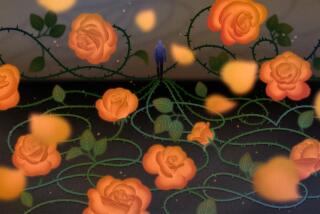Mixed Emotions
The weather was beautiful last Sunday--springtime touched with summer warmth. I got up early and sat outside by the budding magnolia, laptop on my knees, gliding through an assignment that had been baffling me for weeks. I felt I deserved my sociable lunch followed by a trip to a plant nursery to buy old-fashioned wallflowers. Later I would look over my morning’s work and make final adjustments. A perfect day.
In the evening I switched the computer back on. In a moment I was reeling back as if a fist had come out of the screen and clocked me. My work was not there. I tried again; I reeled again. The morning’s paragraphs had not been saved; like unrepentant sinners they were eternally lost. I rocked and groaned; I thumped the desk to mask the cramps, the nausea, the chill. Paragraphs lost! I vainly tried to calm myself with a joke. But then my best friend called: “I’m beside myself at present,” I said, “but I’ll be OK in the morning.” And of course I was.
The paradox of emotions is that we can detach ourselves from them even while we feel overwhelmed. We can observe them obliquely while they sweep us off our feet, and we always know that, like hangovers or toothaches, they will not last. They may bewilder us, but we have plenty of words--rage, hope, terror, jealousy, excitement--to describe them. Moreover the very language of emotions counsels us to be wary of them: Its metaphors advise us to prefer equanimity to agitation, openness to bottling things up and to keep our cool while all around are losing theirs. Our words, as Wittgenstein said, provide us with pictures of the world, and that includes diagrams of our inner lives, models of emotions, itineraries for feelings, and even schemes to live by.
Probably the ideal of calm moral strength is encrypted in all the languages of the world, but it has been worked out with special persistence by the Western philosophical tradition. For the ancient Greeks, wisdom was a matter of character as much as intellect. It meant withstanding the sirens who would lure us into dissipation, indulgence or vice, and mastering the disruptive forces of appetite, anger, fear, bumptiousness, envy, joy, love, hatred, longing and pity. But though the sources of moral errancy were miscellaneous, the Greeks had one word for them all: pathe, or sufferings. The idea was that pathe attacked our moral well-being just as physical illnesses assaulted our bodily health and that we needed regular workouts in the philosophical gym to build up our moral muscles.
The Greek concept of pathe was translated by several Latin words, notably passiones, which emphasized our supposed passivity, and perturbationes, which brought out their restless agitation. And as Susan James has shown in her marvelously lucid “Passion and Action: The Emotions in Seventeenth-Century Philosophy” (1997), the metaphorical complexity grew yet more bewildering when the pathe became the passions, perturbations, sentiments and affections of modern European languages.
Then there was the rise of scientific medicine. If our bodily infections could be brought within the scope of physical laws, then perhaps our mental affections could as well. The word “emotion” (which originally referred to civil unrest) was recruited to the cause of science and, with a little help from Charles Darwin and William James, pathe became a theme for physiologists and psychologists rather than moral philosophers.
But the scientific study of emotions was never going to be straightforward. After all, the phenomena of emotion were originally grouped together for purposes of morality rather than science. Ambrose Bierce may have described emotion as “a prostrating disease,” but his explanation--”a determination of the heart to the head”--was evaluative and metaphorical rather than literally medical. And just as natural science has no use for the gardener’s distinction between crops and weeds or the theologian’s between saints and sinners, so you might expect it to set aside the moralistic folk-concept of emotional agitation and replace it with something more measurable, descriptive and value-free.
The content of emotions adds to the implausibility of trying to explain them scientifically. With their various cocktails of self-esteem, shame and indignation, they are more like echoes of what Nietzsche called “soul-superstitions” than physical effects of natural causes. Jean-Paul Sartre drove the Nietzschean argument home in 1939 with his “Sketch for a Theory of the Emotions,” claiming that emotions are deluded rituals of omnipotence which we enact in the hope of smothering our awareness of cosmic helplessness. When danger threatens, for instance, we cover our eyes as if we thought we could make it disappear. The follies of emotion, according to Sartre, call for existential analysis rather than naturalistic explanation.
Scientific approaches to the emotions had a popular comeback six years ago with Antonio Damasio’s “Descartes’ Error: Emotion, Reason and the Human Brain.” Starting from cases of emotional impairment due to neurological damage, Damasio attacked the orthodox dualism of brain and world by reminding us that the brain is an organ of the body like the liver or the heart, and that consciousness occupies itself not only with our surroundings but with “the structure and states of our body” as well.
Damasio laid out the hard scientific argument of “Descartes’ Error” on a large soft bed of philosophy. He claimed that the Western tradition was deformed by an over-valuation of pure reason, and he recalled, with grandiose vagueness, that he had been “advised early in life . . . that the mechanism of reason existed in a separate province of the mind, where emotion should not be allowed to intrude.” It was a strange thing to tell a boy, but Damasio said it led him, together with his fellow neurologists, to postulate “separate neural systems for reason and emotion.” This was the “error” which he now proposed to slay in the name of science and humanity.
Critics of “Descartes’ Error” suspected Damasio of smoothing his way to facile victory by conjuring up an imaginary opponent, but his most recent book, “The Feeling of What Happens,” shows he has not had second thoughts. Further fragments from his casebook, garnished with citations of Spinoza and Keats and numerous obeisances to the oracle of science, are presented in support of Damasio’s “startling idea” (as he calls it) that “consciousness begins as a feeling.” But when Damasio tells us that emotions are essential to our bodily well-being, he could be reading from a script by Descartes rather than, as he imagines, issuing a bold challenge to him. And when he thanks “science” for teaching him to distinguish conscience (a matter of “good and evil”) from consciousness (“knowing”), we may wonder why he did not simply look it up in a dictionary. He also announces “experimental results from my laboratory” which suggest that emotions are “not dependent on consciousness,” but anyone with a sense of conceptual history will note that it was precisely to express this thought that the category of emotions was invented in the first place.
Aaron Ben-Ze’ev is both more modest and better informed. He is a philosopher by trade but offers a generous harvest from his reading in psychology and sociology, not to mention novels, poems and the Bible. The second half of “The Subtlety of Emotions” has some of the allure of a medical encyclopedia, as it distinguishes between dozens of different emotions our souls are heir to. Some readers will march straight through from envy and jealousy to pridefulness and shame; others, no doubt, will jump to “hurting the one you love,” “loneliness” or “why do we feel bad when you feel good?” But all of us will be able to savor the brackish pleasure of finding ourselves pictured within.
Readers looking for something more astringent will find it in “On the Emotions” by the distinguished British philosopher Richard Wollheim. Wollheim has no delusions about breaking free from philosophical tradition, but this makes his attempts to “re-psychologize” philosophy with the help of Montaigne, Hume, Freud and Klein all the more original. He does not treat intricate issues as if they were simple, but beneath a dense ground cover of details, he has laid the foundations of a large general theory. All our emotions, he thinks, start with a desire; eventually the desire will be either satisfied or thwarted, and we will try to find out why; then we will develop an attitude to the supposed cause, and in the end this attitude will express itself as a kind of bodily feeling. Emotions, as Wollheim shows, are not chaotic eruptions into the stream of consciousness but complex temporal structures with a life cycle of their own. Every emotion tells a story.
*
Wollheim’s ways of recounting the story of an emotion are often so abstract that they are hard to follow, but there is no such problem with Jack Katz. He is a brilliantly inventive UCLA sociologist who has spent 10 years watching what people do when they get emotional. In “How Emotions Work,” he describes children whining, a criminal breaking down under interrogation, holidaymakers sharing laughter and embarrassment in a Parisian hall of mirrors and drivers getting regally pissed off with each other in Los Angeles. Like Wollheim, Katz looks for the stories behind emotions, but he is interested not in third-person stereotypes but in the idiosyncratic autobiographical narratives which we construct for ourselves as part of our emoting.
Katz follows Sartre in regarding emotions as self-scripted scenes in which we attempt to dominate a situation, at least in fantasy, by acting as if we were helplessly out of control, though keeping an eye on our real or imagined audience all the while. Drivers scream inaudible abuse at each other and deploy a rich repertoire of finger signs because they think of their cars as extensions of their bodies and experience disrespectful driving as a personal insult. But once they get out of their mobile isolation units, they allow themselves to be jostled by pedestrians on a sidewalk without losing their good humor. The mise en scene is everything.
Our emotions may feel like sudden explosions or flashes or earthquakes, but in Katz’s analysis they are always structured by “multi-act narratives.” When we get angry at the wheel, we are in the midst of an extended ceremony which began with our dream of the open road, continued with an affront from another driver and now has to be completed in a tournament of champions ending, we hope, with the humiliation of our humiliator. In the same way, distorting mirrors will not make us laugh except as part of a “three-phase process”: We assemble our companions so that we are all looking at the same image; we have a good loud laugh together; and afterward we disperse with nods or waves, probably to reconvene a moment later and start over.
Even episodes of weeping and sobbing turn out to depend on self-designed plots. Katz notes how we exploit trigger words like “heart,” “rosebud” or “mother” to precipitate sublime performances of grief, and he pursues “the narrative work that crying does” through a detailed analysis of infant whingeing with its manipulative ons-and-offs and hackneyed signature tunes. He finds similar methods in a lachrymose murderer for whom sobbing was an element of a “two-track” strategy, part for his own benefit and part for the sake of the police. When we break down in tears, as Katz points out, we feel as if we were struggling to avoid being sucked into a whirlpool and drowned. And he insists that this is not an external analogy, but the verbal maquette on which we model our personification of grief. Take away the words in which we dramatize ourselves, and you take away the emotions as well.
Katz concludes his excellent and entertaining book with an observation which, after annihilating my morning’s work on the computer, I found uncannily prophetic. We experience our emotions, he suggests, on two different time scales: one in response to our immediate situation, the other by telling ourselves “a story about the fateful implications of what is transpiring.” As I observed myself not only lamenting my day’s lost paragraphs but also contemplating a hyperbolical detonation of long-term consequences--missed deadlines, canceled holidays, busted friendships and a life no longer worth living--I could see how right Katz is. It was only an emotion, of course: a typical two-speed emotion, as I could now see. And even though I knew it would not last, for the moment I was at its mercy.
A picture holds us captive, as Wittgenstein said; dozens of pictures in fact. They hold us captive still.


